#Processed World
Explore tagged Tumblr posts
Text


Somewhere in the Lacandon Jungle, Chiapas: The roots of the rebel Zapatista Army of National Liberation (EZLN) have long been intertwined with the roots of what remains of the Lacandon rainforest. The Tzeltal, Tojolabal, Tzotzil and Chol indigenous farmers who now form the core of the EZLN first came to the Lacandon as part of the great stream of settlers that poured into the forest 30 years ago. According to sociologists their long struggle to remain in the region, despite the objections of environmentalists dedicated to preserving the integrity of this unique lowland tropical jungle, have shaped the demands and the militancy of the Zapatista Army. Now, as tensions between the Zapatistas and the Mexican government ratchet up, environmentalists fear renewed hostilities could do irrevocable damage to the rainforest.
When the European invaders first reached this paradisical region in 1530, they literally could not find the forest for the trees. The rainforest extended from the Yucatan peninsula southwest, blending with the Gran Petan of Guatemala at the Usumacinta river, a swatch of jungle matched in the New World only by the Amazon basin. The Lacandon region was a three million acre wilderness of pristine rivers and lakes, its canopy teeming with Quetzales and Guacamayas under which lived ocelots and jaguars, herds of wild boar and tapir, and the Indians who gave the forest its name. The first Lacandones and the Spanish interlopers fought a guerrilla war that did not end until the Indians did — by 1769, there were just five elderly Lacandoes left living outside a mission on the Guatemalan bank of the Usumacinta.
The story of the Lacandon jungle is one of massacres, both of Indians and trees, relates Jan De Vos, the San Cristobal-based historian of the Chiapas rainforest. Soon after Chiapas won its independence from Guatemala and Spain, expeditions were sent to explore the “Desert (jungle) of Ocosingo” — De Vos uses its more poetic name “the Desert of Solitude” — all the way to the juncture of its great rivers, the Jacate and the Usumacinta. Timber merchants soon learned how to move logs on the rivers, and priceless mahogany and cedar groves began to fall. By the turn of the century the jungle was seething with logging camps — monterias — in which the Mayan Indians, gangpressed in Ocosingo, were chained to their axes and hanged from the trees. The conditions in the monterias were exposed to the world in the 1920s in a series of novels by the German anarchist writer Bruno Traven.
Foreign investors bought up huge chunks of the jungle — the Marquis of Comillas, a Spanish nobleman, still lends his name to a quarter of the forest. In the 1950s, Vancouver Plywood, a U.S. wood products giant, bought up a million acres of the Lacandon through Mexican proxy companies, and made another dent in the forest. The Mexican government later cancelled all foreign concessions and installed its own logging enterprise, initialed COFALASA, which took 10,000 virgin mahogany and cedar trees out of the heart of the Lacandon every year for a decade.
The settlers began to stream into the forest in the 1950s, boosted by government decrees that deemed the Lacandon apt for colonization. Choles, pushed out of Palanque, settled on the eastern flanks of the forest. Tzotzil Mayans from the highlands, expelled from landpoor communities like San Juan Chamula under the pretext of their conversion to Protestantism, arrived in the west of the Lacandon, as did landless Tzeltales and Tojolabales, newly freed from virtual serfdom on the great fincas (haciendas) of Comitan and Las Margaritas. In 1960 the Mexican government declared the Lacandon jungle the “Southern Agrarian Frontier” and non-Mayans joined the exodus into the forest. Oaxacan Mixes displaced from their communal lands by government dams, campesinos from Veracruz uprooted by the cattle ranching industry, and landless mestizos from the central Mexican states of Guerrero and Michoacan all pushed through Ocosingo, Las Margaritas and Altamirando, on their way down to the canyons — Las Canadas — towards the heart of the forest. The land rush narrowed the dimensions of the Lacandon and upeed its population considerably. In 1960 the municipality of Ocosingo had a population of 12,000 — the 1990 census was 250,000.
The new settlers were not kind to the forest. Infused with pioneer spirit, the campesinos cut the forest without mercy to charter and extend their ejidos (rural communal production units). Other settlers were more footloose, aligned themselves with the cattle ranchers, slashed and burned their way into the Lacandon, planted a crop or two, and abandoned the land to a cattle ranching industry fueled by World Bank credits. The zone of Las Canadas, the Zapatista base area, was one of the most devastated by the logging and cattle industries.
Two government decrees sought to brake the flow into the forest but backfired badly. In 1972, President Luis Echeverria turned 645,000 hectares of the jungle over to 66 second-wave Lacandon families and ordered all non-Lacandones evicted — settler communities were leveled by the military. Seeking to crystalize communal organizations that could defend the settlers from being thrown off the land they had wrested from the jungle, San Cristobal de las Casa’s liberation Bishop Samuel Ruiz sent priests and lay workers into the region to build campesino organizations such as the Union of Unions, Union Quiptic, and the ARIC — formations from which the Zapatistas arose years later.
Then, in 1978, a new president, Jose Lopez Portillo, added to the turmoil by designating 380,00 hectares at the core of the jungle as the UNESCO-sponsored Montes Azules Biosphere Reserve, declaring that all settlers living inside its boundaries must leave. Forty ejidos, twenty-three of them in the Canadas, were threatened. A young EZLN officer, Major Sergio, remembers well the struggle of his family to stay on their land in Montes Azules: “the government would not hear our petitions. We were left with no road except to pick up the gun.”
Many Zapatista fighters — the bulk of the fighting force is between 16 and 24 years old — were born into the struggle of their parents to stay in the Lacandon in defiance of the Montes Azules eviction notice. “The first experience the young colonos of Las Canadas had with a factor external to their lives was the pressure brought by environmentalists to preserve the forest,” writes sociologist Xochitl Leyva in Ojarasca, a journal of indigenous interests.
A 1989 environmentalist-backed ban on all wood-cutting in the Lacandon also led to resistance and frequent clashes with the newly-created Chiapas forestry patrols. In one of the first EZLN actions, two soldiers, thought to have been confused with forestry patrolmen, were killed in March 1993 near a clandestine sawmill outside San Cristobal.
The EZLN uprising has highlighted the development vs. conservation controversy that has raged in the Lacandon for generations. The EZLN demand that new roads be cut into the region drew immediate objection from the prestigious Group of 100, which, under the pen of poet-ecologist Homero Aridjis, complained the new roads would mean “the death of the Lacandon.” The Zapatista demand for land distribution also worries Ignacio March, chief investigator at the Southeast Center for Study and Investigation (CEIS), who fears the jungle will be “subdivided” to accomodate the rebels.
“Ecologists? Who needs them? What we need here is land, work, housing,” Major Mario remarked to La Jornada earlier this winter, when questioned about the opposition of the environmental community to EZLN demands.
The June 10th EZLN turndown of the Mexican government’s 32-point peace proposal has heightened fears of renewed fighting, a worst-case scenario for ecologists. S. Jeffrey Wilkerson, director of the Veracruz-based Center for Cultural Ecology worries that a military invasion of the Lacandon by the Mexican Army would mean the cutting of many roads into untouched areas, the use of destructive heavy machinery, the detonation of landmines, bombings and devastating forest fires and even oil well blow-outs.
Because of national security considerations, PEMEX, the government petroleum consortium, does not disclose the number of wells it is drilling in the Lacandon — some researchers think there are at least a hundred. From the air, the roads dug between oil platforms scar the jungle floor, and painful bald patches encircle the drilling stations.
One of the Zapatistas’ most important contributions to preserving the integrity of the Lacandon was to force 1400 oil workers employed by PEMEX, U.S. Western Oil, and the French Geofisica Corporation to shut down operations and abandon their stations during the early days of the war.
Despite disputes with the environmental community, the EZLN may be one of the most ecologically-motivated armed groups ever to rise in Latin America. The Zapatista Revolutionary Agrarian Law calls for an end to “the plunder of our natural wealth” and protests “the contamination of our rivers and water sources,” supports the preservation of virgin forest zones and the reforestation of logged-out areas. The lands they demand, the rebels insist, should not be shorn from the Lacandon but rather stripped from the holdings of large landowners.
The EZLN approach to the forest in which they and their families have lived for decades draws grudging approval from some environmentalists. “Few armed groups have ever included these kinds of demands in their manifestos” comments CIES investigator Miguel Sanchez-Vazquez. Andrew Mutter of the Lacandon preservationist Na’Bolom Institute is also sympathetic to the environmental roots of the EZLN: “this revolution rose from the ashes of a dead forest...”
#ecologist#Processed World#Zapatistas#deep ecology#anarchism#revolution#climate crisis#ecology#climate change#resistance#community building#practical anarchy#practical anarchism#anarchist society#practical#daily posts#communism#anti capitalist#anti capitalism#late stage capitalism#organization#grassroots#grass roots#anarchists#libraries#leftism#social issues#economy#economics#anarchy works
40 notes
·
View notes
Text

processed world magazine #12
8 notes
·
View notes
Text

1 note
·
View note
Text

Life in an Autism World
#autism#actually autistic#sensory processing#sensory overload#sensory issues#auditory processing#it isn’t always about loudness#neurodivergence#neurodiversity#actually neurodivergent#feel free to share/reblog#Life in an Autism World (Facebook)#autism acceptence month#autism awareness month
28K notes
·
View notes
Text
More thoughts on Clark fantasizing about sweaty Bruce "in a friend way":
The reason this lasts so long is coz every time Clark considers that maybe this behaviour isn't normal, he looks over at Bruce who's doing the exact same thing and thinks "nah, this is how friends act, totally bros"
He's memorising his heartbeat and scent? Bruce has already studied every inch of his body in great detail multiple times
He's interested in learning more about Bruce's parents and childhood? Bruce has been learning to speak kryptonian and studying the culture for years now
He treats the bat kids like his own kids? Bruce literally buys the bank his parents owe money to so they can keep the farm
He stares at the man's scars for a bit too long in the changing rooms? Bruce just full on looks him in the eye while he strips down then continues on like nothing happened
This man has not only matched his freak, he's doubled it and put a batsymbol on it
#It's funnier if bruce is having the same thought process of “this is normal. Clark's doing the same thing”#superbat#batman#bruce wayne#clark kent#superman#worlds finest#dc comics#bruce x clark#superbat fanfiction#superbat fic
3K notes
·
View notes
Text












This took way too long for a comic that's supposed to be self-indulgent and quick,, Apologies if the chat bubbles are confusing on who's talkin..
Anyway another comic for my AU! I'm not sorry for the lack of background cause I really wanted to just focus on the dialogue lawl
Extra doodles I did while making the comic if ya'll want some of it:


#During the process of making this it reminded me why I'd rather stick to making short comics than a full series#my artstyle losing and gaining quality each panel over and over#this isn't even fully shaded and i already took way too long for my taste#Anyway another session of me yapping in tags#it's the fact i had to post this in my laptop and not my phone cause of the photo limit#which i didn't even know Tumblr had#not too happy with the results maybe i should've not coloured this help#hope it's okay ajkds#field research au#dandys world#dandy's world#dandys world fanart#dandys world sprout#dandys world au#dandys world brightney#dandys world connie#dandys world goob#dandys world looey#ronu's artwork
2K notes
·
View notes
Text
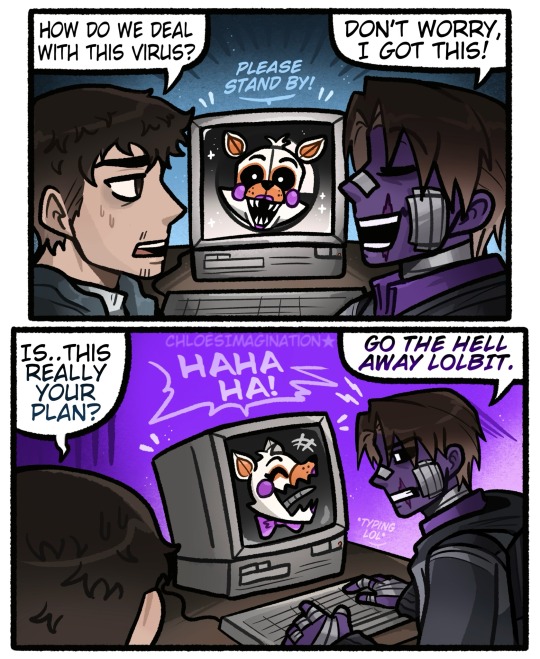
Michael knows how to deal with FNAF Lolbit
#myart#chloesimagination#comic#fnaf#michael afton#mike schmidt#lolbit#fnaf movie#sister location#fnaf world#fnaf fanart#five nights at freddy's#LOLBIT MEMTIONED 💜🧡#I’ve been asked a bit to draw LOLBIT so I’m glad I finally did!!!#michael is so good at his job#he tbh probably does find lolbit annoying#but Lolbit did nothing wrong#they are just a silly lil creature pulling some pranks#Mike doesn’t get Michael’s plan but he just has to trust the process
5K notes
·
View notes
Text

something something a chat i am in discussing the loneliness of Armand who needs someone to define him and see him, so
"...it was ghastly and awful and loathsome, and beautiful all at the same time."
and yeah i kinda just want to give ppl hugs with anything i do and talk to them in hushed tones, so there you go
#art is a coping mechanism#fan art#interview with the vampire#daniel molloy#iwtv armand#armand de romanus#vampire armand#armand#eric bogosian#assad zaman#i still need to figure out Assad's anatomy#he's too beautiful#it makes the process tougher#Eric's face is fascinating in a completely different way#Assad's features seem simple to capture because ANIME VIBE but it's all about the tiny nuances#artist's rant#lots of words in the tags#also tmi but i perceive the world through touch and boy does sketching Eric tingle my brain in the best manner#iwtv spoilers#iwtv fanart#iwtv art#amc iwtv#devil's minion#armandaniel
3K notes
·
View notes
Text
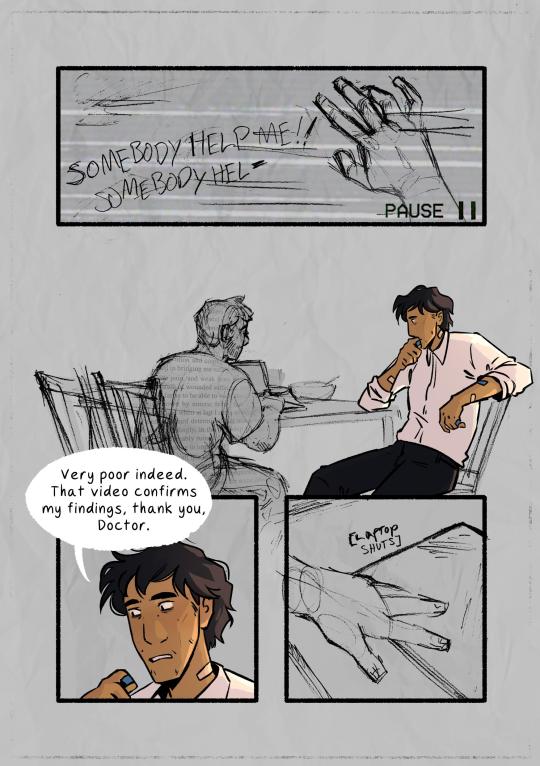




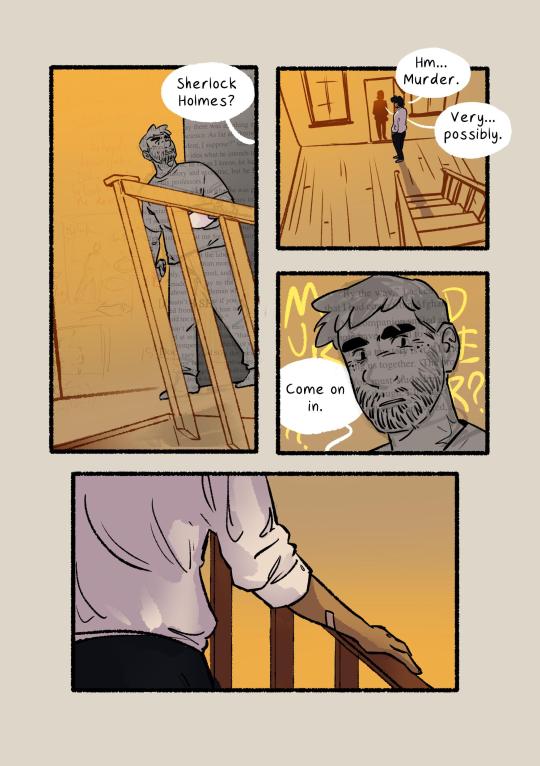



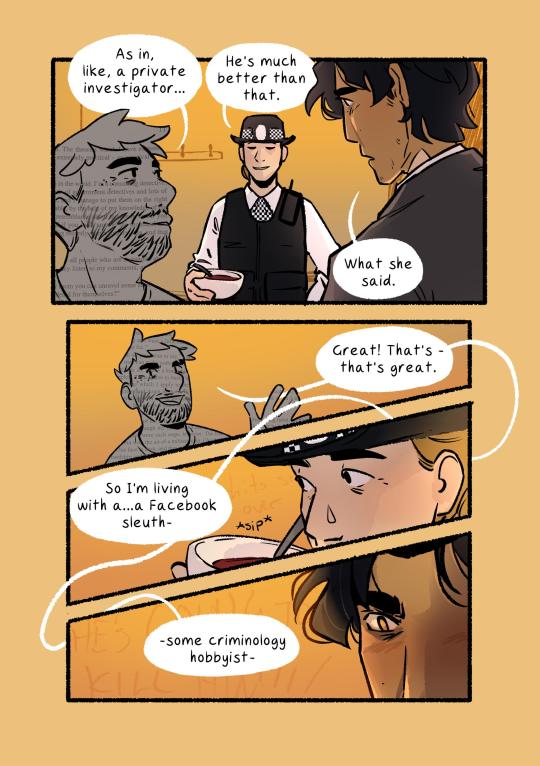

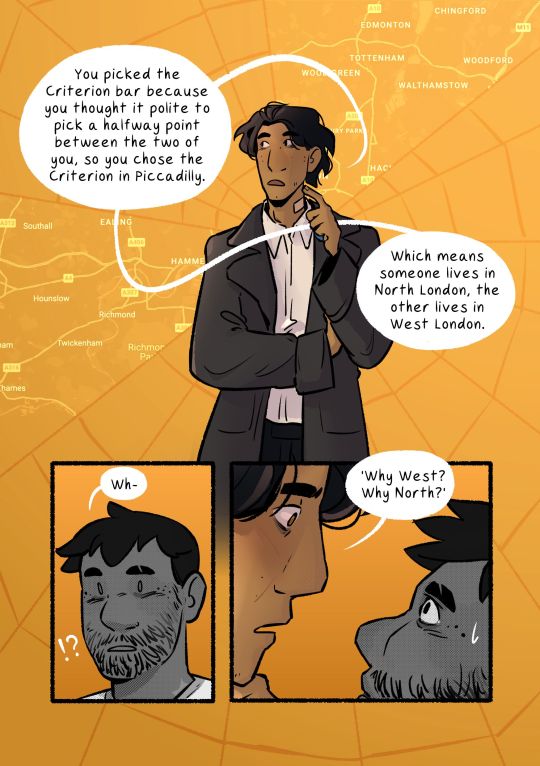
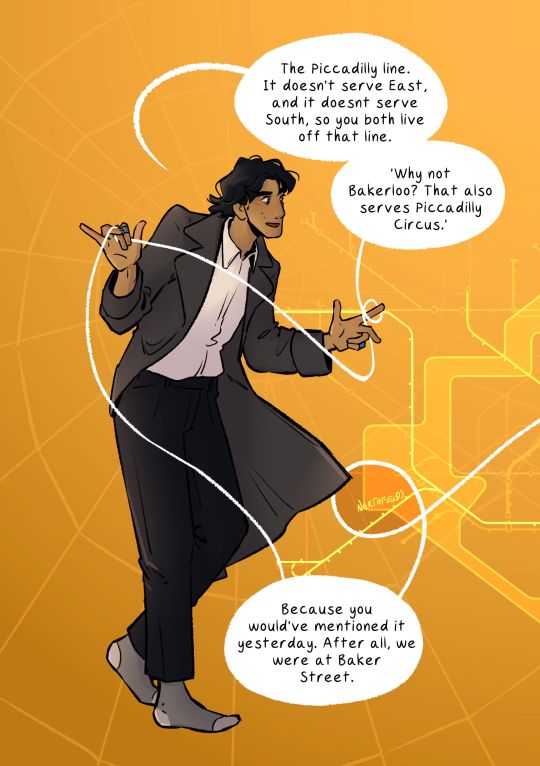



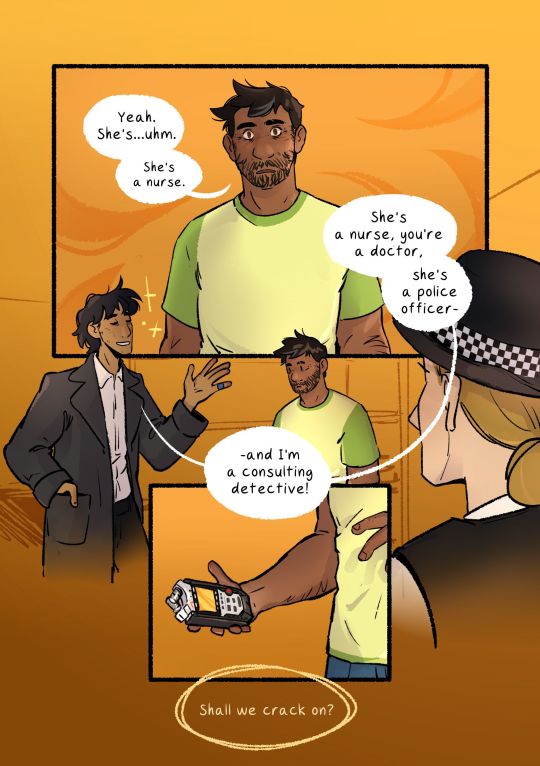
Happy 1 year anniversary to Mr Sherlock Holmes! Here's a litttleee celebratory comic from me
#sherlock & co#sherlock and co#writing these tags on the 29th of september#which is when john and sherlock ACTUALLY met <3#so there you go#uh once again shout out to candy for letting me talk through some of my processes#it helps immensely and i really wanted to be sure i was getting across what i wanted to with this one#speaking of which - usually i yap a lot in the tags of these bcus i love talking about art#for this one...im not sure i want to comment too much#because i'll be here forever and i think most things can speak for themself#but let me say this one thing#for the first five pages i was drawing john on paper and sherlock on the computer exclusively#and then bringing them together..#uh it really made me think of paul and harry. recording on opposite sides of the world. brought together by the power of editing#its not a particularly emotional scene but i hope ive infused it with. something.#anyway thats it from me#if u want to ask about any particular aspect i would love to yap about the process but i'll just leave it here for now or i'll never shut u#happy 1 year podpals#patsart#oh yeah i will say i did have to take quite a bit of liberty with the audio in order to do what i wanted. forgive me#or dont idc
3K notes
·
View notes
Text

4 notes
·
View notes
Text
the story of this zine is wonderful! i listened to an interview with one of the founders, Chris Carlsson, on Tech Won't Save Us:
https://techwontsave.us/episode/231_escaping_the_processed_world_w_chris_carlsson
It can feel like we're the first people to say "it's bad that tech is a tool of capitalism" but there's a long history, and also i always love hearing about collective zine projects from the past. Worth a listen. There's also links to more info are writing on the zine, and the full archives of it, at the podcast page.
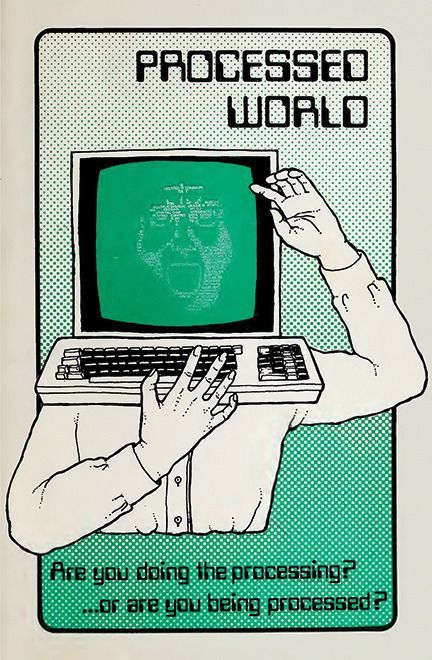
808 notes
·
View notes
Text
wow it just hit me that. bucky said “i love you” to sam. bucky barnes. told sam wilson. that he loved him. BUCKY SAID THAT HE LOVES SOMEONE? oh my god. woah. this is hitting me. “I LOVE YOU”
#good lord i’m not okay ive literally processed this already and the damn movie was what drew me back to marvel but damn.#marvel#mcu#bucky barnes#sam wilson#captain america brave new world#sambucky#marvel cinematic universe#captain america#the falcon and the winter soldier
967 notes
·
View notes
Text

2K notes
·
View notes

